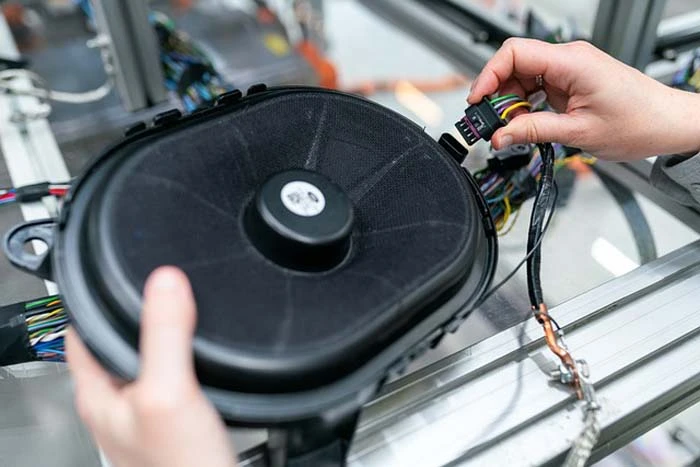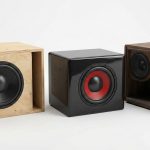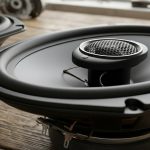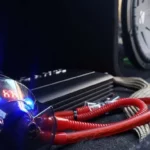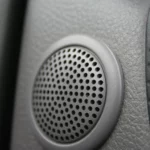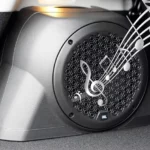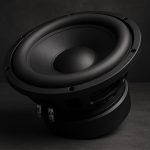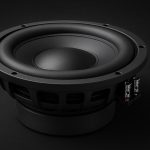If you find that the car speaker on one side is not working, there could be several reasons for this issue. One possibility is that the speaker itself may be damaged or blown out, requiring replacement. Additionally, a loose or disconnected wire could be the culprit, preventing the speaker from receiving the necessary electrical signal. Another potential cause may be a faulty amplifier or receiver, as they play a crucial role in delivering audio signals to the speakers. Lastly, a problem with the car's wiring system or a blown fuse may also result in a non-functional speaker. To fix the issue, it is recommended to check the speaker connections, inspect the wires for any damages, and examine the amplifier or receiver.
Have you ever turned on your car stereo and noticed that the speakers only playing on one side of the car? If so, you are not alone, most car owners have experienced this problem at some point in their lives. This can be very annoying and frustrating, especially if you love listening to music while driving.
So, how can you fix this problem and restore your vehicle speaker system to its optimal condition? Don’t worry, we have got you covered. In this article, we will show you some of the most common problems that cause the speaker to work improperly on one side, and how you can easily and effectively solve them with some simple tools and techniques. Read on to find out more.
Understanding Car Audio Systems
A car audio speaker system consists of four main components: speakers, subwoofers, amplifiers, and head units. Speakers are the devices that convert electrical signals into sound waves. Subwoofers are specialized speakers that produce low-frequency sounds, such as bass. Amplifiers are devices that boost the power of the electrical signals from the head unit to the speakers and subwoofers. Head units are the devices that control the source and the audio output signals, such as radio, CD player, or smartphone.
Vehicle speakers produce sound by using a magnet and a coil of wire to create vibrations in a cone-shaped diaphragm. Together, the magnet and coil constitute an electromagnet that oscillates upon passage of an electrical current. This motion is responsible for imparting pressure on air molecules by the diaphragm, thereby when you turn on the stereo, it initiates the propagation of sound waves that ultimately reach our auditory system.
Related Post: How Many Speakers Are In My Car: Decoding Car Speaker Numbers
Reasons For Car Speakers Not Working On One Side
1. Physical Damage
If the speaker does not work properly on one side, physical damage could be the culprit. Over time, the speaker cone can become damaged or distorted. Check whether the speaker is cracked or torn and ensure that it’s securely fastened to its posts. If the speaker is damaged, You might need to replace the speakers in your car.
2. Wiring Problems
One of the most common causes of bad speakers is faulty wiring in your car. These can include loose or damaged wires and RCA cables, poor connections, corrosion, or short circuits. Wiring problems can affect the power supply, the signal transmission, or the speaker impedance.
3. Blown Speakers
If a car is not working smoothly, the blown speaker could be the reason. Excessive exposure of speaker to power, heat, moisture, or physical damage can lead one of the speakers to stop working. Blown speakers can produce no sound, low sound, distorted sound, or crackling sound.
4. Faulty Head Units
A less common but still possible issue with the speaker is defective head units. These can happen when the head unit is old, defective, or incompatible with the speakers. Faulty head units can produce no sound, low sound, distorted sound, or uneven sound.
5. Faulty Amplifiers
A less common but still possible cause of vehicle speaker problems that can affect either front speakers or rear speakers is defective amplifiers. These can happen when the amp is old, defective, or incompatible with the speakers. Defective amplifiers can produce no sound, low sound, distorted sound, or uneven sound.
These are some of the most common causes of car sound systems not working on one side. Of course, there may be other causes that are less common or more specific to your situation.
Related Post: 13 Expert Tips To Make Car Speakers Louder Without Amp
Symptoms Of A Car Speaker Not Working On One Side
1. No Sound Or Low Volume
You may have to turn up the volume to hear anything, or you may hear nothing at all. This can happen if the speaker is bad. It can be a blown or damaged speaker, or there can a problem with the head unit or the amplifier.
2. Distorted Sound
There may be buzzing, humming, or hissing noises or the music may be unclear or lacking in bass. This can happen if there is dust inside the speaker or they are worn out, or if there is an issue with your head unit’s equalizer settings, that makes speaker not to work effectively.
3. Crackling Or Popping Sound
Static or interference noises may be heard, or the sound may go out abruptly. This can occur if a wire is loose or exposed, or if a short circuit occurs in the speaker or head unit. These reasons cause a speaker to produce crackling or popping sound.
4. Uneven Or Unbalanced Sound
The sound may come from one side more than the other, or it may fade in and out. This can happen if your head unit’s balance and fading settings are improper, or if there is a problem with the electrical connections or the speaker itself.
Steps To Diagnose One Side Speaker Not Working
1. Identifying Which Car Speaker Is Not Working
To begin, identify the non-working side. This can be achieved by playing music or any sound on your vehicle’s stereo system and paying close attention to each speaker and find out which isn’t working. Utilizing the balance and fade configurations on your amp or head unit can also help pinpoint which speaker is affected and whether it is producing sound.
2. Conducting A Visual Inspection
The subsequent action to take is to visually examine the speaker and its wiring. To carry this out, the speaker grille or cover must be taken off and inspected for indications of damage such as chips, ruptures, scorch marks, or erosion. Additionally, it is possible to examine the audio cables linking the speaker to the head unit or amp and verify if they are not taut, damaged, or unraveled.
3. Evaluating The Speaker By Playing Audio Through It
To examine why the sound from both speakers is not smooth, one can use an outside sound gadget such as a cellphone, MP3 player, or portable speaker. This can be accomplished by removing the connections of the speaker wires from the head unit or amp and subsequently connecting them to the audio device with the help of wire stripper and electrical tape. After this, play some sound through the audio source to determine if the speaker operates properly.
4. Using A Multimeter For Continuity Testing
A multimeter is a tool capable of measuring the voltage, current, resistance, and continuity. It can be used to test for the existence of a complete circuit between the speaker terminals and the head unit or amp terminals. To do this, set the multimeter to continuity mode and touch one probe to each speaker terminal and the other probe to each head unit or amp terminal. If there is a beep or a reading on the multimeter display, it indicates good wiring and continuity. Conversely, if there is no beep or reading, it signifies a break in the wiring and a lack of continuity, hence bad car radio.
How To Fix Car Speakers Not Working On One Side
Step 1: Check the Fuse
Checking the fuse is crucial when diagnosing vehicle speaker problems. A blown fuse is one of the most common reasons why the speaker might not be working on one side of your car. After finding the location of the fuse, pull it and make sure that the leads are not corroded and that the fuse has not been broken or popped. If it has, simply replace your car speaker’s fuse with a new one of the same rating.
Step 2: Checking The Speaker Connections
Occasionally, the speaker could cease functioning due to an inadequate or loose attachment between the wires of the speaker and the head unit or amp terminal. To remedy this issue, one may inspect the wires for a secure attachment to the terminal by dismantling the speaker grille or cover. Alternatively, one might utilize a wire crimper or soldering iron to ensure a robust, tight connection.
Step 3: Inspecting And Replacing Damaged Wires
A damaged wire could be the potential reason for either side speaker not working as it can hinder the transmission of electrical signals to the speaker. To fix the issue, one should examine the wires for any signs of cuts, breaks, or fraying and replace them with new ones if necessary. Minor damage can be repaired using wire strippers, electrical tape, wire nuts, or heat shrink tubing.
Note: If your speakers are in your car doors, they might stop working because the wires that go from the door to the frame can break over time. Even though there is a rubber cover protecting the wires, they can still get damaged. This can make all of the speakers stop working. To fix this, you can check if any wires are touching the metal of the car when the doors are open or closed.
Step 4: Testing The Speaker With A Different Audio Source
In case the speaker fails to function even after an external audio source test, it could indicate that the speaker is either defective or damaged. To validate this, test whether the speaker is working appropriately with a separate audio source that functions well, like another automobile stereo setup or a home cinema system. If it works with another audio source, it suggests that your vehicle audio setup or its settings have issues. If it fails to work with another audio source, it is time to buy a new set of speakers.
Step 5: Verifying Balance And Fade Settings
Occasionally, it is possible for the speaker to malfunction due to the incorrect balance and fade settings on either the head unit or amp. These settings are responsible for regulating the volume of sound that each speaker in the car stereo system receives. By adjusting the balance and fade settings to ensure they are equally centered for all speakers, the issue can be resolved.
Step 6: Testing The Speaker With A Multimeter
If you used a multimeter to check for continuity in both left and right speaker and it didn’t produce a beep or reading, this indicates that there is a disconnect in the wiring somewhere between the amp or head unit and the speaker. To resolve this issue, you can locate the break in the wiring by following it from both ends, and then replace or fix the wiring if needed.
Step 7: Checking The Head Unit Or Amplifier
If you have attempted all the previous actions and the speaker is still not functioning properly, it could imply that there is an issue with either your head unit or amplifier. You can determine this by testing the head unit or amp with a known functional speaker. If the head unit or amp operates with the substitute speaker but not with the original one, it indicates that your original speaker is damaged and requires replacement. If the head unit or amp does not work with the replacement speaker either, it means that either repair or replacement of the head unit or amp is necessary.
Common Mistakes to Avoid When Fixing Car Speaker
1. Disregarding The Manual
When troubleshooting the speaker issues of your vehicle, it’s important not to disregard the manual. The manual contains important information for your specific car and speaker system, including wiring diagrams and troubleshooting tips. It’s easy to overlook this valuable resource, but referring to the manual can save time and prevent further damage to your vehicle audio system.
2. Ignoring Factory Settings
Ignoring factory settings can lead to issues with car sound systems not working on one side. It is important to check the balance settings and make sure they are in the middle position. Overlooking the basics can also cause problems, so it is essential to follow the manufacturer’s instructions carefully. Always check the manual before attempting any troubleshooting.
3. Not Using The Right Tools And Materials
It is a big mistake people usually make by not using the right tools and materials. To install a car audio system, you’ll need a screwdriver, pry tool, trim removal tool, multimeter, auxiliary cable, Bluetooth adapter, electrical tape, wire connectors, soldering equipment, and new speakers or wires. It is critical to use tools and materials that are appropriate for and compatible with your vehicle’s sound system. If you lack the necessary tools or supplies, you can purchase them from our website or borrow them from a friend.
4. Not Testing The System After Fixing The Problem
This is another big mistake people do not testing the system after fixing the problem. After the problem has been resolved, it is vital to assess the system’s performance and confirm that it is functioning as intended. Listen to music or audio through your vehicle’s sound system and evaluate the acoustics of each speaker.
How To Prevent Car Speaker From Damaging
- Clean and dry your speakers regularly to prevent dust, dirt, moisture, and debris from damaging them.
- Avoid extreme temperatures and sunlight that can cause your speakers to expand, contract, or fade and affect their performance and durability.
- Adjust the volume and equalizer settings on your head unit or steering wheel to avoid damaging your speakers and find a balance that suits your preference and comfort level.
- Replace your speakers regularly to avoid wearing them out over time and check their condition and performance every few months or years.
What Kind Of Solder Do I Use For Speaker Wire
The type of solder that you utilize for the speaker wire is reliant on the quality and type of wire, along with the type of connection you intend to create. Typically, you should make use of a solder that possesses great electrical conductivity, low melting point, and great resistance to corrosion. It is also highly advisable to use a solder that includes a rosin core, which is a type of flux designed to bond and clean the metal surfaces.
Tin/lead solder is frequently chosen to solder speaker cables due to its beneficial properties such as low melting point, excellent electrical conductivity, and powerful corrosion resistance. Nonetheless, this type of solder contains lead, which is detrimental to the environment and harmful to health. Therefore, it’s advisable to use tin/lead solder with care and in well-ventilated areas.
Lead-free solder has gained popularity for speaker cables. It comprises of a mixture of tin and other metal elements like copper, silver, or bismuth. This variation of solder is safe and environmentally friendly as it lacks lead. However, it possesses downsides such as higher melting point, lower electrical conductivity, and more prone to corrosion than tin/lead solder. Hence, it is advisable to handle this form of solder with caution and proper temperature regulation.
Recap Of Key Points
As a vehicle audio specialist technician, one common issue that customers face is when the sound system is not working on one side. This could be due to various reasons such as a blown speaker, damaged wiring, or a defective amp. It’s important to determine the source of the problem before fixing it. Testing every component of the sound system is essential to ensure the correct repair approach. By following the steps mentioned in this article, you can fix your vehicle speaker issues on one side and enjoy uninterrupted music on your driving journey.
Final Thoughts
As a vehicle audio specialist, it’s crucial to recognize the importance of fixing car sound systems not working on one side. Neglecting these issues can lead to frustration and a subpar listening experience, potentially damaging the system’s overall performance. Whether it’s a blown speaker, defective amp, or damaged wiring, addressing the problem head-on can prevent further complications down the line. Don’t let time constraints or lack of experience prevent you from rectifying these issues. Instead, seek professional help or take the necessary steps to solve the problem yourself. By doing so, you’ll enjoy a clear, crisp, and balanced audio experience while on the road.
FAQs
If one side of your speaker stop working, it could be due to a loose or damaged wire connecting the speaker to the stereo system, a damaged speaker, or a software issue.
If your car’s one speaker is not working, it is due to a problem with the wire, the speaker, the amp, the connection, or the equalizer/crossover.
To fix the sound coming out of one speaker, You can try checking and fixing the speaker jack, the speaker cable, the speaker itself, the audio settings, and the audio drivers.
The cost to fix a blown speaker in a car depends on the type and size of the speaker, but it can range from $50 to $1000 or more.
Related Post: How Much Does It Cost To Replace Car Speakers 2023
This could be due to a defective aux cable, a worn out jack, or a problem with the input selector or another switch.
Your left speaker could have gone out due to a problem with the sound settings, the audio service, the speaker cables, the speaker itself, or the amp.
Only your right speaker may be working because the left speaker is muted, disconnected, defective, or blown. Due to such issues, one of the audio speakers can be affected.
